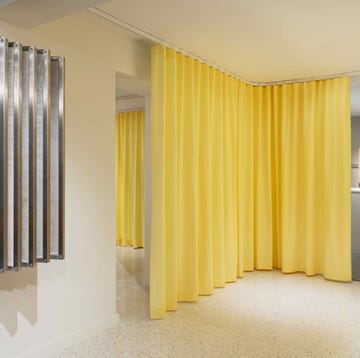In 1928, Farmers’ Bulletin, an American publication dedicated to rural life, published a cotton-textiles report by Ruth O’Brien of the Bureau of Home Economics. Ms O’Brien, clearly a taciturn woman, defined chambray as ‘plain-weave, smooth, shiny surface’. Her abrupt tone was perhaps because she felt that defining chambray to an audience of American farmers was pointless: this was, after all, very much their fabric.
The name chambray is derived from that of a northern French town, Cambrai, renowned for its linen textiles from the 16th century onwards. Cambrai was best known for producing cambric, a lightweight, undyed linen. Like cambric, chambray is a plain-weave: the simplest kind of weaving, where the weft threads alternate over and under the warp ones.
Chambray, however, is distinctively coloured, with the warp threads being dyed – typically, but not exclusively, blue – while the weft ones are white. It’s light and soft, with a fine, dense weave, and excels at keeping the wearer cool by wicking moisture away from the skin. It was this quality that led to chambray’s association with American farmers. During the latter decades of the 1800s and into the early 1900s, work shirts were a sartorial semaphore for rugged manual labourers: miners, gold- panners, foresters, sailors, cowboys. Manufacturers began to market their clothes accordingly, emphasising how hardwearing and tear- resistant the work shirts were, how well-placed and roomy the pockets, how airy, light and cool. Chambray was ubiquitous.
What's everyone reading?
Like many similarly understated workhorses – think gingham, denim and wool jersey – chambray has proved too useful to remain pigeonholed for any single purpose. Picked up by leisured youth in the first half of the 20th century and then again by the likes of Ralph Lauren and J Crew in the 1980s and 90s, chambray became intrinsic to the studied insouciance of the preppy look. In style terms, it has never really looked back since.
In interiors, use of chambray has always been more low-key: the bridesmaid rather than the bride. However, there are signs that the fabric may be due a moment in the spotlight. A similar tint (‘Upward’) was chosen by paint brand Sherwin-Williams as its colour of 2024, while Pantone selected ‘Chambray Blue’ as one of its spring colour trends.
The textile itself easily dovetails with an upcoming aesthetic some have dubbed ‘country club’, others ‘coastal lifestyle’ or ‘old money’: essentially a more refined, preppier and put-together twist on the farmhouse style that has been popular for the past decade. Still welcoming and informal, this allows for a more personal take on the trend’s usual colour palette and is more sympathetic to modern spaces. All this plays to chambray’s strengths: used as bedlinens, tablecloths, napkins and cabinet curtains, its appealingly practical, low-key efficiency might be enough to impress even Ruth O’Brien of the Bureau of Home Economics.

















